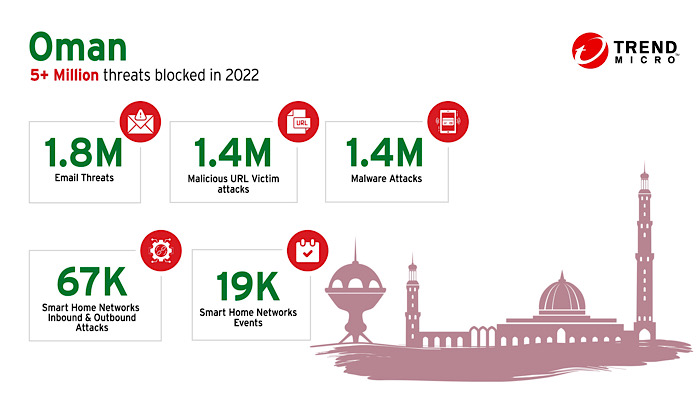
Muscat: Trend Micro Incorporated, a global leader in cybersecurity solutions, predicts that ransomware groups will increasingly target Linux servers and embedded systems over the coming years. The latest Trend Micro 2022 Midyear Roundup Report recorded a double-digit year-on-year (YoY) increase in attacks on these systems in H1 2022.
In Oman, Trend Micro solutions detected and blocked over 1.8 million email threats, and prevented more than 1.47 million malicious URL victim attacks, and 10,914 URL hosts. In addition, over 1.4 million malware attacks were identified and stopped.
“Omani enterprises have valiantly fought against a rapidly evolving threat landscape, yet challenges remain in protecting the expanding attack surface,” said Assad Arabi, Managing Director of Gulf Cluster, Trend Micro. “To safeguard digital environments, it is essential to implement multilayered cyber security. The most recent midyear report is a crucial resource for guiding organisations toward a smarter and more powerful approach against future security challenges in the digital sphere."
Detection of attacks from ransomware-as-a-service (RaaS) surged in the first half of 2022. Major players like LockBit and Conti were detected with a 500 per cent YoY increase and nearly doubled the number of detections in six months respectively. The RaaS model has generated significant profits for ransomware developers and their affiliates. According to the data, Trend Micro blocked 63 billion threats in H1 2022, there were 52 per cent more threats in the first half of the year than in the same period in 2021, while government, manufacturing, and healthcare were among the top three sectors targeted with malware.
The report also highlights the ongoing risks of remote and hybrid work and learning environments. Backed by Trend Micro’s Smart Home Network (SHN) solutions, Oman blocked a total of 67,258SHN inbound and outbound attacks and prevented 19,373SHN events for hackers to target or control home devices from executing malware, obtaining sensitive information, intercepting communications, or launching external attacks.
New ransomware groups are emerging every day. In the first half of 2022, Black Basta was the most notable. Even though SMBs are a more popular target, many threat actors tend to go for large corporations. Vulnerability exploitation is a common ransomware attack vector. Unpatched vulnerabilities contribute to a growing digital attack surface that many organisations are struggling to secure as hybrid workplaces expand their IT environment. More than two-fifths of global organizations (43%) believe it is "spiralling out of control."
Furthermore, cloud visibility is crucial given the persistent risk posed by third parties using methods like cloud-based crypto mining and cloud tunnelling to exploit misconfigured environments. Threat actors frequently use the latter to host phishing websites or route malware traffic.